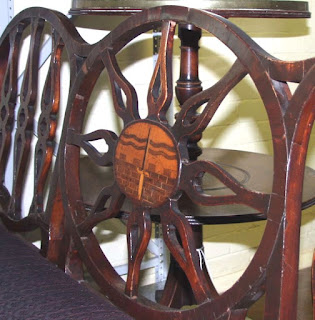Part 2 – The Furniture
Not many people know that St John’s store is home to wonderful pieces of furniture. Some have simply appeared in the collection over the years, others donated but mostly it is made up of funiture acquired for council buildings to be used as functional objects rather than collected for their beauty….
Five Seat Rout Bench
This mahogany rout bench was made specifically for the Pump Room, and named after the formal evening parties held in the late 18th Century. Its prototype was designed and made by William Birchall of Queen’s Square, who was employed by Bath Corporation in 1777 to make a pattern settee ‘as a model’ for others to follow. The central design depicts the Bath City Coat of Arms in mahogany veneer and satinwood. The bench seat was originally covered in crimson check. |
| Bath City Coat of Arms |
William Morris Secretaire Bookcase (1894) and William Morris Display Case (1895)
Until recently these beautiful mahogany and satinwood pieces were used to dress the Victorian Scene in the Fashion Museum’s Panorama Room. Both pieces came into the collection via a bequest from the Henderson family. They were made in London towards the end of William Morris’s life. Born in Walthamstow in 1834 William Morris became famous for his work in the visual and decorative arts. His work included book design, calligraphy, furniture, paintings, drawings, stained glass, tapestries, textiles, and wallpapers. |
| BATRM 2006.31 and BATRM 2006.28 William Morris Pieces |
Card Table
This 19th Century Dutch ornate marquetry card table is inlaid with birds, scroll foliage and playing cards. The veneer has faded over time and would originally have been much brighter. Playing cards was a popular pastime in Georgian Bath. |
| BATRM 2006.278 Card Table |
Bench
Mahogany bench from the time of William IV (early – mid 19th Century). The design reflects a new taste for classical simplicity, symmetry and elegance, in the style known as neo-classical, which appeared during the late Georgian period.
 |
| BATRM 2006.21 Bench |
The store is open to the public several times a year, with the next store open day on Saturday 9th June 2012 from 11am until 3pm. Please do come along and visit us – for more information and directions please follow this link http://www.romanbaths.co.uk/whats_on/events/behind_the_scenes_tours.aspx
https://www.facebook.com/#!/events/296443413763889/







